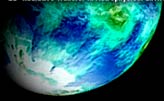
|
|
The universe is full of small dust particles which block most electromagnetic radiation shorter than micron wavelengths, re-emitting it in the infrared. As a result, many objects are completely obscured in optical wavelengths; indeed, this is the reason for the dark lanes visible to the naked eye in the milky way. For generations this was considered the bane of astronomy, but recent progress in IR techniques (airborne and satellite observatories as well as development of detectors and array cameras) has turned dust observations into one of the primary tools of study of the formation of stars and galaxies. Interpretation of the wealth of new data requires rather complex radiative transfer analysis, a challenging computational task. |
|

